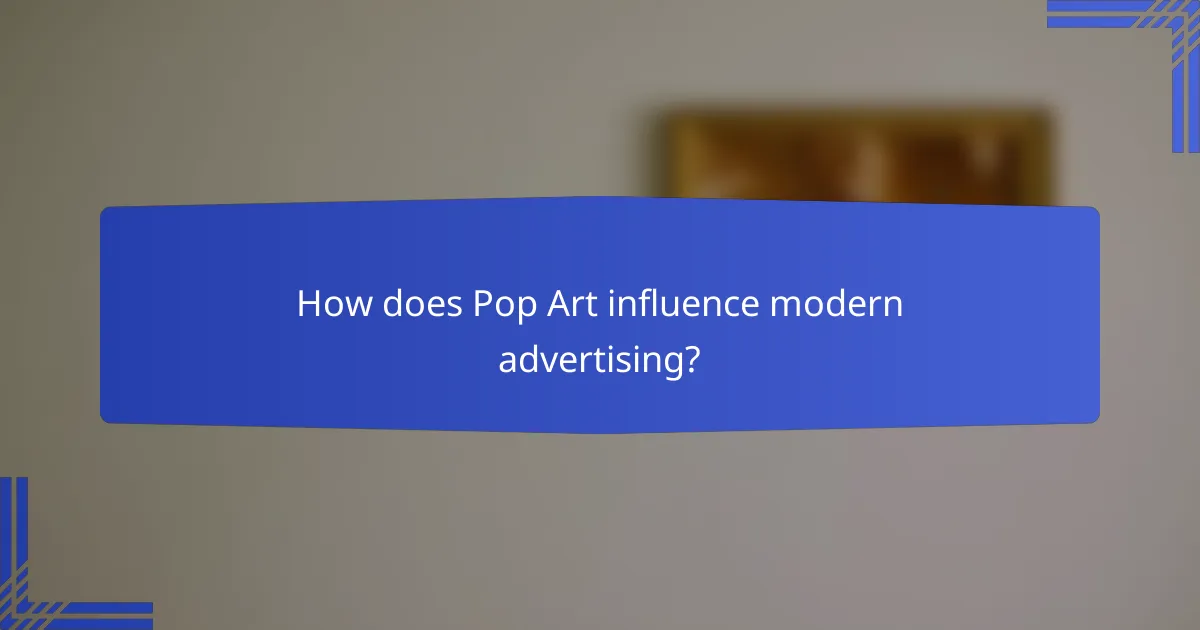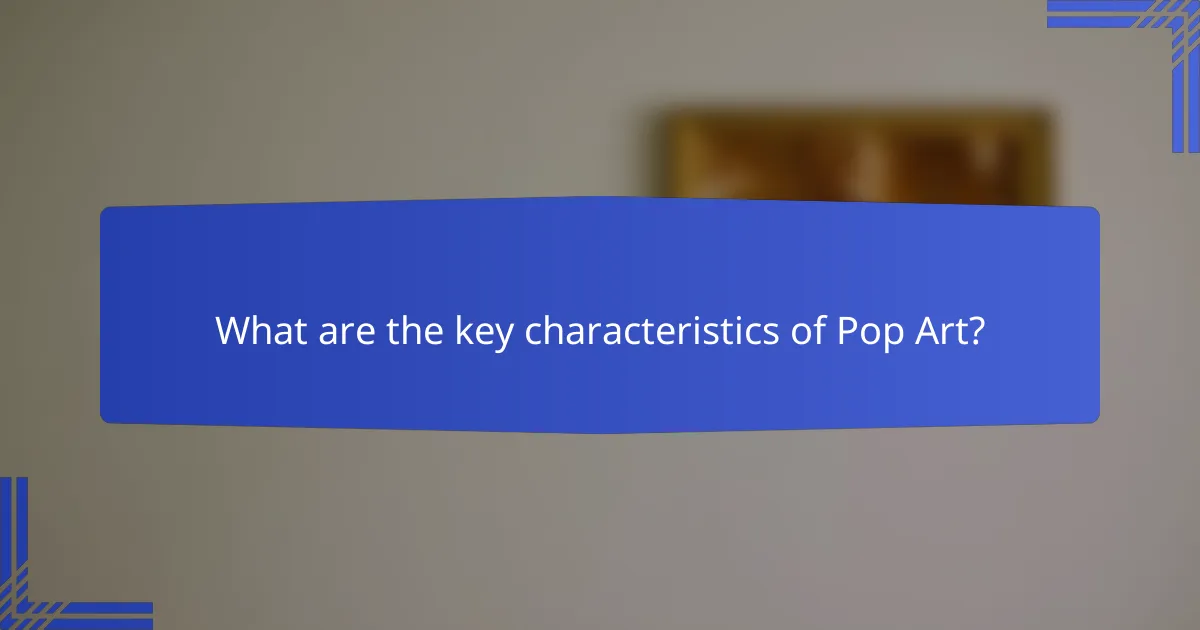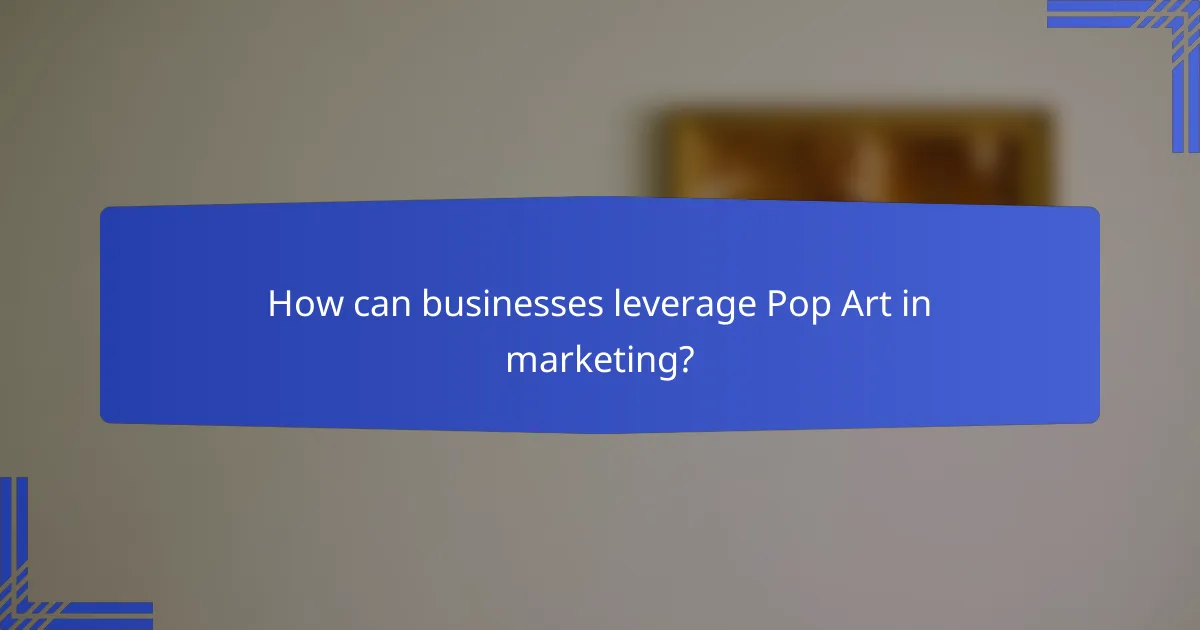Pop Art emerged in the mid-20th century as a vibrant movement that blurred the lines between high art and popular culture. Characterized by bold colors and the incorporation of commercial imagery, it transformed everyday objects and media into art, making them more relatable and engaging. Influential artists like Andy Warhol and Roy Lichtenstein utilized these techniques to redefine artistic expression and impact modern advertising.

How does Pop Art influence modern advertising?
Pop Art significantly influences modern advertising by incorporating vibrant aesthetics and commercial techniques that resonate with popular culture. This movement emphasizes bold visuals and familiar imagery, making advertisements more engaging and relatable to consumers.
Use of bold colors
Bold colors are a hallmark of Pop Art, capturing attention and evoking emotions. Advertisers leverage this technique to create striking visuals that stand out in a crowded marketplace. For instance, brands often use bright primary colors to evoke feelings of excitement and energy, appealing to younger demographics.
Using a limited color palette can also enhance brand recognition. When a brand consistently employs specific bold colors, it becomes easily identifiable, fostering a strong visual identity that consumers can quickly associate with the product.
Commercial techniques
Pop Art employs commercial techniques such as repetition and appropriation, which are effective in advertising. Repetition reinforces brand messages, making them more memorable. For example, using the same image or slogan across various platforms can strengthen consumer recall.
Appropriation involves taking familiar cultural icons and recontextualizing them, which can create a sense of nostalgia or humor. Brands often use this technique to connect with consumers on a personal level, making their advertisements more relatable and impactful.
Integration with digital media
The integration of Pop Art elements into digital media has transformed advertising strategies. Social media platforms, with their emphasis on visual content, provide an ideal space for bold and vibrant advertisements that capture user attention. Brands can create shareable content that resonates with audiences, driving engagement and brand loyalty.
Additionally, digital tools allow for dynamic and interactive advertisements that incorporate Pop Art styles. This can include animated graphics or augmented reality experiences that immerse consumers in the brand’s message, enhancing the overall impact of the advertising campaign.

What are the key characteristics of Pop Art?
Pop Art is characterized by its vibrant colors, incorporation of popular culture elements, and the use of commercial imagery. This art movement emerged in the mid-20th century, challenging traditional boundaries between high art and everyday life.
Vibrant color palettes
One of the most striking features of Pop Art is its use of bold and vibrant color palettes. Artists often employ bright primary colors, along with contrasting hues, to create visually engaging works that capture attention. This approach not only enhances the aesthetic appeal but also reflects the energy of consumer culture.
When creating Pop Art, consider using colors that evoke strong emotions or associations. For example, red can signify excitement, while yellow often represents optimism. Experimenting with color combinations can lead to unique and eye-catching results.
Incorporation of popular culture
Pop Art draws heavily from popular culture, including advertisements, comic strips, and celebrity imagery. This incorporation serves to blur the lines between fine art and mass media, making art more accessible and relatable to the general public. Artists like Andy Warhol famously used images of Marilyn Monroe and Campbell’s Soup cans to comment on fame and consumerism.
To effectively incorporate popular culture into your work, consider what resonates with your audience. Use recognizable symbols or figures that reflect contemporary society, ensuring that your art speaks to current trends and cultural phenomena.
Use of commercial imagery
The use of commercial imagery is a hallmark of Pop Art, as it often employs techniques from advertising and graphic design. This includes the replication of images, bold typography, and the incorporation of brand logos. By utilizing these elements, artists critique and celebrate consumerism simultaneously.
When using commercial imagery, be mindful of copyright issues. While some artists transform these images enough to create original works, others may face legal challenges. Always consider the implications of using recognizable commercial elements in your art.

Which artists are pivotal in the Pop Art movement?
Key artists in the Pop Art movement include Andy Warhol, Roy Lichtenstein, and Claes Oldenburg. Their innovative use of popular culture, bold colors, and commercial techniques helped define the genre and influence contemporary art.
Andy Warhol
Andy Warhol is perhaps the most iconic figure in the Pop Art movement, known for his unique approach to mass production and consumerism. His famous works, such as the Campbell’s Soup Cans and Marilyn Diptych, exemplify the use of commercial imagery and vibrant colors.
Warhol’s technique often involved silkscreen printing, allowing him to reproduce images in a way that mirrored the mass media’s impact on society. This method not only challenged traditional notions of originality in art but also blurred the lines between fine art and commercial products.
Roy Lichtenstein
Roy Lichtenstein is celebrated for his comic strip-inspired paintings that transformed everyday imagery into high art. His works, characterized by bold colors and Ben-Day dots, mimic the visual style of comic books, making them instantly recognizable.
By elevating popular culture to the level of fine art, Lichtenstein questioned the boundaries of artistic expression. His pieces, such as “Whaam!” and “Drowning Girl,” often feature dramatic narratives that engage viewers while reflecting on consumerism and romance in American society.
Claes Oldenburg
Claes Oldenburg is known for his large-scale sculptures that humorously reinterpret everyday objects, such as food and household items. His work often combines elements of Pop Art with a playful approach to form and scale, creating engaging installations that invite interaction.
Oldenburg’s iconic pieces, like the giant soft hamburger or the oversized clothespin, challenge perceptions of art and functionality. By transforming mundane items into monumental sculptures, he encourages viewers to reconsider their relationship with consumer goods and the culture surrounding them.

How is Pop Art perceived in the UK?
In the UK, Pop Art is viewed as a vibrant expression of popular culture that merges fine art with commercial techniques. Its bold colors and imagery resonate with the public, reflecting societal trends and consumerism.
Influence on contemporary artists
Contemporary artists in the UK often draw inspiration from Pop Art’s playful aesthetics and its commentary on mass media. Many incorporate similar techniques, such as the use of bright colors and commercial imagery, to challenge traditional art forms.
For example, artists like Damien Hirst and Banksy utilize elements of Pop Art to critique consumer culture and societal norms. This blending of styles encourages a dialogue between art and everyday life, making it more accessible to a broader audience.
Public exhibitions and installations
Public exhibitions of Pop Art in the UK, such as those at the Tate Modern or the Saatchi Gallery, showcase the genre’s enduring appeal. These installations often feature interactive elements that invite viewer participation, enhancing the connection between the art and the audience.
Events like the annual London Art Fair frequently highlight Pop Art, attracting both collectors and casual visitors. Such exhibitions emphasize the importance of Pop Art in contemporary discourse, making it a staple in the UK’s cultural landscape.

What are the commercial applications of Pop Art?
Pop Art has various commercial applications that leverage its vibrant aesthetics and cultural relevance. Brands utilize Pop Art techniques to enhance their visibility and connect with consumers through innovative marketing strategies.
Brand collaborations
Brand collaborations in Pop Art often involve partnering with artists to create unique products that resonate with target audiences. For example, fashion brands may collaborate with Pop Art artists to design limited-edition clothing lines that feature bold graphics and colors.
These partnerships can enhance brand image and attract new customers, particularly among younger demographics who appreciate artistic expression. Successful collaborations often result in increased sales and heightened brand awareness.
Merchandising strategies
Merchandising strategies utilizing Pop Art focus on creating visually striking products that stand out in retail environments. Items such as home decor, clothing, and accessories can be designed with iconic Pop Art motifs to appeal to consumers seeking distinctive styles.
Effective merchandising may include eye-catching displays and promotional materials that highlight the artistic elements. Brands should consider seasonal trends and cultural events to maximize the impact of their Pop Art-inspired merchandise.
Art licensing
Art licensing allows brands to use Pop Art images on various products while compensating the original artists. This practice can include licensing artwork for use on packaging, advertisements, or promotional items, providing a revenue stream for artists and a fresh aesthetic for brands.
When pursuing art licensing, companies should ensure they have clear agreements that outline usage rights and compensation. This not only protects the artist’s work but also fosters a positive relationship between brands and creators.

How can businesses leverage Pop Art in marketing?
Businesses can effectively leverage Pop Art in marketing by utilizing its vibrant colors and commercial techniques to create memorable campaigns. This art style resonates with popular culture, allowing brands to connect with audiences in a visually striking manner.
Creating eye-catching visuals
Pop Art is known for its bold colors and graphic designs, making it an excellent choice for creating eye-catching visuals. Businesses can incorporate these elements into advertisements, packaging, and social media posts to capture attention quickly. Using high-contrast colors and playful imagery can enhance visual appeal and encourage engagement.
Consider using iconic Pop Art styles, such as comic book aesthetics or repetitive patterns, to create a unique look. Brands like Campbell’s Soup and Coca-Cola have successfully employed these techniques to stand out in crowded markets.
Engaging target audiences
To engage target audiences, businesses should align their Pop Art marketing strategies with the interests and values of their demographic. This can involve using culturally relevant references or collaborating with contemporary artists who resonate with the target market. Engaging storytelling combined with Pop Art visuals can create a deeper connection with consumers.
Interactive campaigns, such as social media challenges or user-generated content inspired by Pop Art themes, can further enhance audience participation. Brands that successfully engage their audience often see increased loyalty and word-of-mouth promotion.
Enhancing brand identity
Integrating Pop Art into marketing can significantly enhance brand identity by establishing a distinctive visual language. This approach allows businesses to differentiate themselves from competitors and create a memorable brand image. Consistency in using Pop Art elements across various platforms helps reinforce brand recognition.
For example, a brand might adopt a specific color palette or artistic style reminiscent of Pop Art in its logo and promotional materials. This not only attracts attention but also communicates a fun and modern brand personality, appealing to younger consumers.
